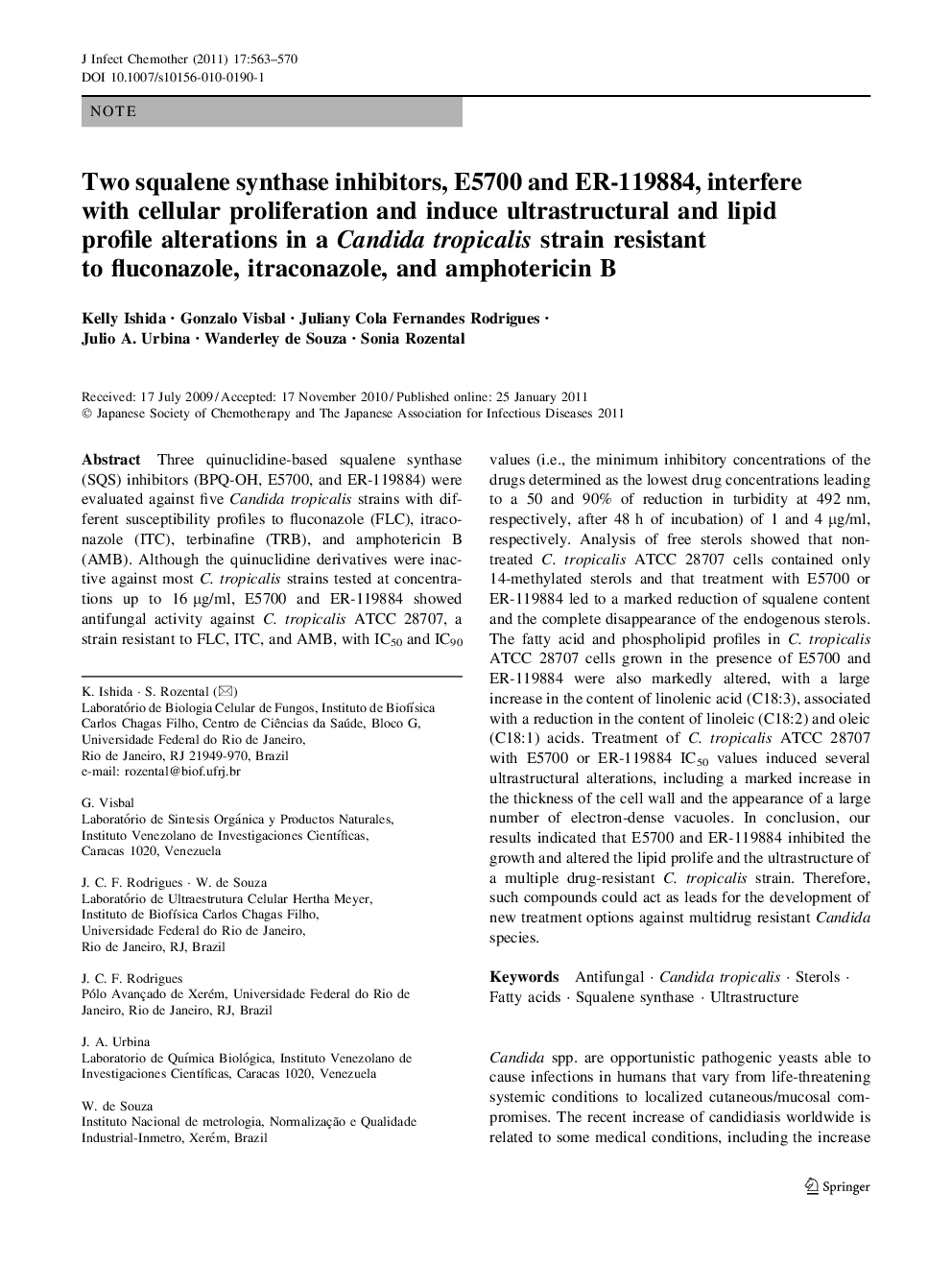| کد مقاله | کد نشریه | سال انتشار | مقاله انگلیسی | نسخه تمام متن |
|---|---|---|---|---|
| 6124167 | 1219962 | 2011 | 8 صفحه PDF | دانلود رایگان |
عنوان انگلیسی مقاله ISI
Two squalene synthase inhibitors, E5700 and ER-119884, interfere with cellular proliferation and induce ultrastructural and lipid profile alterations in a Candida tropicalis strain resistant to fluconazole, itraconazole, and amphotericin B
دانلود مقاله + سفارش ترجمه
دانلود مقاله ISI انگلیسی
رایگان برای ایرانیان
کلمات کلیدی
موضوعات مرتبط
علوم زیستی و بیوفناوری
ایمنی شناسی و میکروب شناسی
میکروبیولوژی و بیوتکنولوژی کاربردی
پیش نمایش صفحه اول مقاله

چکیده انگلیسی
Three quinuclidine-based squalene synthase (SQS) inhibitors (BPQ-OH, E5700, and ER-119884) were evaluated against five Candida tropicalis strains with different susceptibility profiles to fluconazole (FLC), itraconazole (ITC), terbinafine (TRB), and amphotericin B (AMB). Although the quinuclidine derivatives were inactive against most C. tropicalis strains tested at concentrations up to 16 μg/ml, E 28500 and ER-119884 showed antifungal activity against C. tropicalis ATCC 28707, a strain resistant to FLC, ITC, and AMB, with IC50 and IC90 values (i.e., the minimum inhibitory concentrations of the drugs determined as the lowest drug concentrations leading to a 50 and 90% of reduction in turbidity at 492 nm, respectively, after 48 h of incubation) of 1 and 4 μg/ml, respectively. Analysis of free sterols showed that non-treated C. tropicalis ATCC 28707 cells contained only 14-methylated sterols and that treatment with E 28500 or ER-119884 led to a marked reduction of squalene content and the complete disappearance of the endogenous sterols. The fatty acid and phospholipid profiles in C. tropicalis ATCC 28707 cells grown in the presence of E 28500 and ER-119884 were also markedly altered, with a large increase in the content of linolenic acid (C18:3), associated with a reduction in the content of linoleic (C18:2) and oleic (C18:1) acids. Treatment of C. tropicalis ATCC 28707 with E 28500 or ER-119884 IC50 values induced several ultrastructural alterations, including a marked increase in the thickness of the cell wall and the appearance of a large number of electron-dense vacuoles. In conclusion, our results indicated that E 28500 and ER-119884 inhibited the growth and altered the lipid prolife and the ultrastructure of a multiple drug-resistant C. tropicalis strain. Therefore, such compounds could act as leads for the development of new treatment options against multidrug resistant Candida species.
ناشر
Database: Elsevier - ScienceDirect (ساینس دایرکت)
Journal: Journal of Infection and Chemotherapy - Volume 17, Issue 4, 2011, Pages 563-570
Journal: Journal of Infection and Chemotherapy - Volume 17, Issue 4, 2011, Pages 563-570
نویسندگان
Kelly Ishida, Sonia Rozental, Gonzalo Visbal, Juliany Cola Fernandes Rodrigues, Wanderley de Souza, Juliany Cola Fernandes Rodrigues, Julio A. Urbina, Wanderley de Souza,